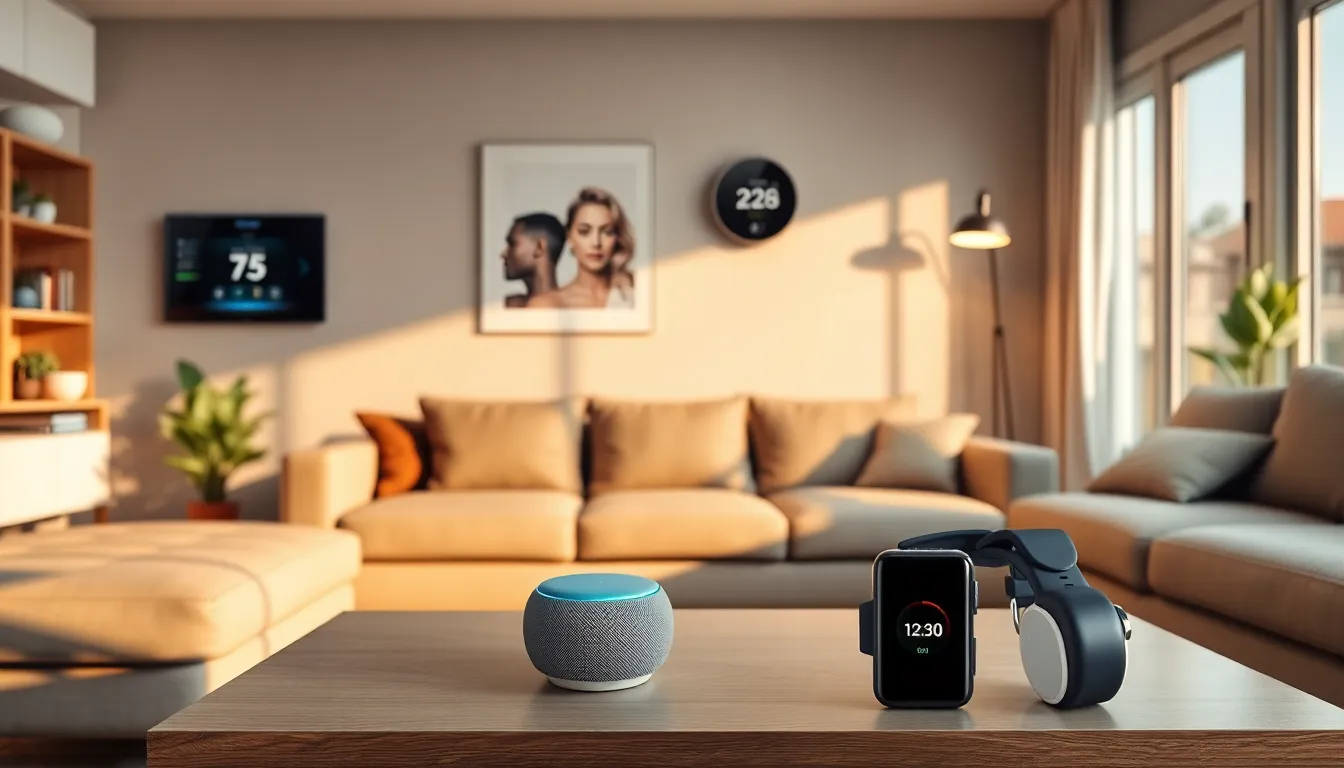Table of Contents
ToggleGadget trends are constantly evolving, shaping the way people interact with technology. From smart home devices to wearable tech, these innovations not only enhance daily life but also redefine convenience and connectivity. As consumers seek smarter solutions, manufacturers are racing to meet the demand with cutting-edge designs and features that promise to make life easier.
In 2023, several key trends are emerging that will impact how gadgets are used and integrated into everyday routines. Sustainability is taking center stage, with eco-friendly materials and energy-efficient designs becoming a priority. Meanwhile, advancements in artificial intelligence and machine learning are making gadgets more intuitive than ever, allowing them to adapt to users’ needs. Understanding these trends can help consumers make informed choices and stay ahead in a rapidly changing tech landscape.
Overview Of Gadget Trends
Gadget trends in 2023 showcase significant innovations that enhance convenience, efficiency, and user experience. Smart home devices, such as smart speakers and home automation systems, streamline daily tasks and integrate seamlessly with various technologies. Wearable tech continues to evolve, offering health tracking and fitness features that appeal to a broad audience.
Sustainability drives gadget design, with many brands opting for eco-friendly materials and energy-efficient technologies. Manufacturers often prioritize recyclable materials and low-energy consumption in product development.
Artificial intelligence (AI) and machine learning (ML) advancements improve gadget performance, making devices more intuitive and responsive. Smart assistants, powered by AI, enhance user interaction by providing personalized experiences.
Companies are investing heavily in user-centric designs, focusing on ergonomic features and aesthetic appeal. Connectivity remains crucial, with 5G technology enabling faster communication between devices and enhancing overall functionality.
The trend toward modularity allows users to upgrade or replace specific components easily, extending the lifespan of gadgets. This approach promotes sustainability while offering flexibility based on individual needs and preferences.
Keeping track of these trends helps consumers find the gadgets best suited for their evolving lifestyles, ensuring they stay informed of the latest advancements in technology.
Emerging Technologies

Emerging technologies are redefining gadget trends in 2023, with artificial intelligence (AI) and the Internet of Things (IoT) leading the charge. These advancements enhance user experiences and streamline daily tasks.
Artificial Intelligence Integration
Artificial intelligence integration in gadgets plays a crucial role in creating smarter devices. AI algorithms analyze user behavior, enabling gadgets to provide personalized recommendations and automate routine tasks. Voice-activated assistants, like Amazon Alexa and Google Assistant, exemplify this trend by facilitating hands-free operation and improving accessibility. Machine learning capabilities allow devices to learn and adapt, enhancing their functionality over time. As AI continues to evolve, the potential for further innovations in user experience expands.
Internet Of Things (IoT) Growth
The growth of the Internet of Things (IoT) enhances connectivity among devices, allowing them to communicate seamlessly. Smart home systems integrate IoT technologies to control lighting, security, and temperature from remote locations. Reports indicate that the IoT market is expected to reach 1.1 trillion USD by 2026, demonstrating significant consumer interest and investment. Wearable devices, like fitness trackers and smartwatches, exemplify IoT growth, collecting health data and syncing it with other devices for comprehensive health monitoring. This interconnected ecosystem increases efficiency and convenience in everyday life, reinforcing the intricate link between technology and lifestyle.
Wearable Technology
Wearable technology significantly influences gadget trends in 2023. This category includes fitness trackers and smartwatches, each designed to enhance personal health and connectivity.
Fitness Trackers
Fitness trackers monitor physical activity, heart rate, and sleep patterns, providing users with valuable health insights. Popular models include Fitbit Charge 5 and Garmin Venu 2, which offer features like GPS tracking and exercise recognition. According to a report by Grand View Research, the fitness tracker market is projected to reach $70 billion by 2027, driven by rising health awareness and demand for real-time health monitoring. Users benefit from personalized fitness plans, motivating them to achieve their health goals.
Smartwatches
Smartwatches extend the functionality of traditional timepieces by integrating mobile applications and health monitoring capabilities. Models like Apple Watch Series 8 and Samsung Galaxy Watch 5 allow users to receive notifications, make calls, and track fitness metrics. A study from Counterpoint Research indicates that the global smartwatch market is expected to grow to $96 billion by 2027, as consumers increasingly seek multifunctional devices. Smartwatches enhance user experience with customizable watch faces and seamless integration with smart home devices, allowing for improved task management and connectivity.
Sustainable Gadgets
Sustainable gadgets play a crucial role in modern technology, reflecting a commitment to environmental responsibility. The emphasis on eco-friendly materials and energy-efficient designs marks a significant shift in the gadget industry.
Eco-Friendly Materials
Gadget manufacturers increasingly prioritize eco-friendly materials in their products. Biodegradable plastics, recycled metals, and sustainably sourced wood offer alternatives to traditional materials. For instance, companies like Fairphone utilize recycled materials in their smartphones, promoting a circular economy. Other brands, such as Dell, incorporate post-consumer recycled plastics in their devices, reducing waste and the environmental impact of production. Using these sustainable materials reduces the carbon footprint associated with gadgets and appeals to environmentally conscious consumers.
Energy Efficiency
Energy efficiency serves as a cornerstone of sustainable gadget design. Devices designed for low energy consumption significantly reduce power usage over their lifecycle. Smart home devices, such as energy-saving light bulbs and smart thermostats, optimize energy use and minimize waste. Smart thermostats like Nest can save users up to 15% on heating and cooling costs annually, showcasing the potential financial and environmental benefits. Furthermore, the Energy Star certification programs help consumers identify products that meet strict energy efficiency guidelines, encouraging more eco-friendly purchasing decisions. These innovations not only promote sustainability but also ensure that users enjoy long-term savings and enhanced usability.
Consumer Preferences
Consumer preferences in gadgets reflect a shift towards personalization and the impact of social media. These factors significantly shape purchasing decisions and user engagement.
Personalization In Gadgets
Personalization in gadgets enhances user satisfaction and functionality. Consumers favor devices that adapt to their individual preferences, offering features that cater to unique needs. For example, smart speakers provide personalized playlists, while fitness trackers offer tailored fitness goals. A survey shows that 70% of users prefer gadgets with customization options. Brands respond by integrating machine learning algorithms that analyze user behavior, delivering tailored content and recommendations. Personalization extends to user interfaces, allowing consumers to adjust layouts and functionalities according to their preferences.
Impact Of Social Media
Social media profoundly influences gadget trends and consumer choices. Platforms like Instagram and TikTok serve as major sources of inspiration for tech enthusiasts. Nearly 60% of consumers report that social media impacts their gadget purchasing decisions. Influencers showcase the latest gadgets, often highlighting innovative features and personalized uses, resulting in increased brand visibility. Online reviews and unboxing videos create buzz, directly affecting consumer trust and interest. Additionally, social media campaigns drive engagement and promote eco-friendly gadgets, aligning with consumer values. By harnessing the power of social media, brands effectively connect with their audience and adapt to emerging preferences.
As gadget trends continue to evolve in 2023 the focus on sustainability and advanced technology reshapes consumer expectations. The integration of AI and IoT enhances not only functionality but also the overall user experience. Wearable tech and smart home devices are becoming essential tools for health monitoring and convenience.
Manufacturers are responding to the demand for eco-friendly products by prioritizing sustainability in their designs. This commitment not only benefits the environment but also aligns with consumer preferences for personalization and connectivity.
Staying informed about these trends empowers consumers to make choices that reflect their values and lifestyles, ensuring they embrace the future of technology with confidence.




